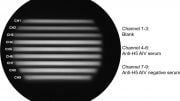
Currently, they are attempting to refine the device to detect and measure THC in exhaled breath and to make it smaller so that it can be used as a handheld breathalyzer or ignition interlock device.
A fuel cell sensor developed by UCLA researchers can detect the presence of THC by oxidizing it to produce an electric current.
A chemist from the University of California, Los Angeles, and colleagues are one step closer to developing a handheld device that can detect THC on a person’s breath after they’ve smoked marijuana, similar to an alcohol Breathalyzer.
Professor of organic chemistry at UCLA Neil Garg and researchers from the UCLA start-up ElectraTect Inc. describe the method by which THC introduced, in a solution, into their laboratory-built device can be oxidized, producing an electric current whose strength indicates how much of the psychoactive compound is present. Their research was recently published in the journal Organic Letters.
According to the researchers, the availability of a Breathalyzer-like device might contribute to making roads safer given the recent legalization or decriminalization of marijuana in many states, including California. Marijuana use has been linked to dramatically increased accident risk and has been demonstrated to impair certain driving skills.
Garg and UCLA postdoctoral researcher Evan Darzi found in 2020 that removing a hydrogen molecule from the larger THC molecule allowed it to shift colors detectably. The process, called oxidation, is similar to how alcohol breath analyzers turn ethanol into an organic chemical compound through the loss of hydrogen. This oxidation results in an electric current in the majority of modern alcohol breath analyzer tools, which indicates the presence and concentration of ethanol in the breath.
Since their 2020 finding, the researchers have been working with their patent-pending oxidation technology to develop a THC breath analyzer that works similarly. ElectraTect has exclusively licensed the patent rights from UCLA.
How the new device works
In the new paper, Darzi, now the CEO of ElectraTect, Garg, and ElectraTect researchers detail how their new laboratory-scale THC-powered fuel cell sensor functions. When THC (known scientifically as Delta-9-tetrahydrocannabinol) comes into contact with a negatively charged electrode, or anode, on one side of the device’s H-shaped glass chamber, it oxidizes into a new compound called THCQ, sending electrons across the chamber to a positively charged electrode, or cathode, on the other side, generating a measurable electric current. The higher the concentration of THC molecules, the stronger the current.
The advance marks the first time THC has been used to power a fuel cell sensor. The researchers said they expect that the relatively simple, inexpensive technology, once perfected, can be scaled up for economical mass production, and they are currently working to refine the device to detect and measure THC in exhaled breath and to shrink it to a more compact size suitable for use in a handheld breath analyzer or ignition interlock device — a breath analyzer connected to a vehicle’s ignition that prevents it from starting if THC is detected.
Making marijuana testing easier — and fairer
Beyond the implications for improved roadway safety, the technology has the potential to make marijuana law enforcement fairer, the researchers said. Generally, urine or blood tests are used to detect the presence of THC in drivers. Not only are such tests difficult to administer at the roadside, but because the compound can linger in the body for weeks after marijuana use without any residual cognitive effects, these tests aren’t always useful for identifying impaired drivers. This ambiguity can lead to fines, imprisonment, or loss of employment, even if an individual is not high when tested.
Such issues, the researchers said, highlight the need for innovative forensic technologies that are easier to use and more accurate for detecting recent marijuana use. And while a commercial marijuana breath analyzer based on their technology would still be several years off, Darzi and Garg stressed that such a tool could ultimately have benefits beyond traffic safety and law enforcement. Their technological breakthrough, they said, could ultimately be used in any situation where fair marijuana testing is critical, including in the workplace, where employees might be operating machinery, or even at home, where individuals may one day be able to use it proactively — before they ever get behind the wheel.
Reference: “A Cannabinoid Fuel Cell Capable of Producing Current by Oxidizing Δ9-Tetrahydrocannabinol” by Di Huang, Christina R. Forbes, Neil K. Garg and Evan R. Darzi, 12 September 2022, Organic Letters.
DOI: 10.1021/acs.orglett.2c02289









IMHO, overdose-safe drugs (like DMT, THC, LSD, Psilocybin etc) (which are actually safer than alcohol!) legally should/must be treated same as alcohol (which is really just another (similar) kind of drug)!
IMHO, just like prohibition of alcohol had caused so much crime in the past (& that is why it was repealed many years later), prohibition of many similar drugs are causing so much crime today!
We need to take lesson from history & end “War On Drugs”!!
(Not to mention, (according to many medical research) drugs like DMT, THC, LSD, Psilocybin seem to be extremely promising against (major) depression & PTSD!)
(& what benefits alcohol or tobacco have exactly (& yet they are legal)?)